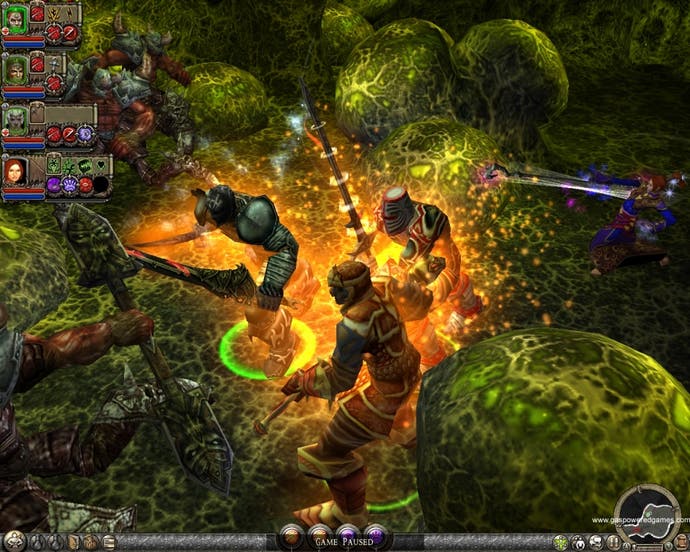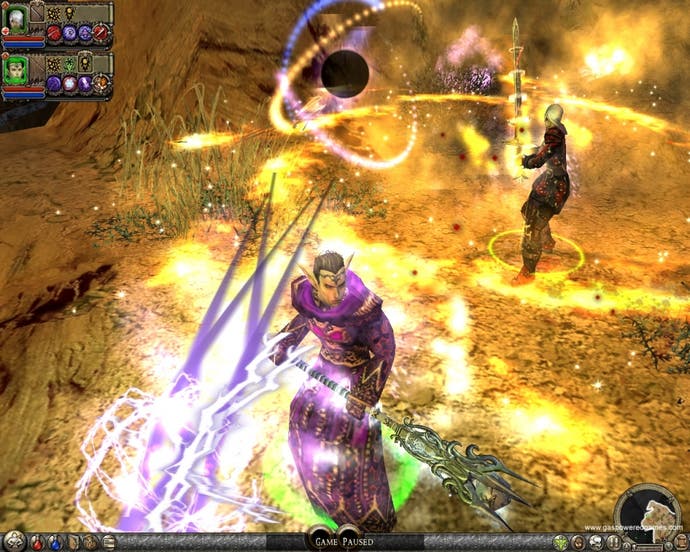Dungeon Siege II
DUNGeon siege, more like. Er... except not.
How many people have you killed? It's a nagging question for a games fan. How many simulated murders have you committed? I've been playing games for a couple of decades. For the newer generation, even if you're in your early teens, you'll probably have been gaming in some form since you were five. Hell – even earlier if you were suckled on the Nintendo-teats of the late nineties. While games like God of War may seem like the killers, it's the quiet turn-based world of Civilisation where the real numbers pile up. Burn that town? Why not. Oh, there goes another few million.
I've no idea how many my particular score is. However, I do know that after playing Dungeon Siege 2 it has received a healthy increase.
This isn't a dungeon crawl. This is genocide.
Dungeon Siege II picks up where its prequel left off. Almost literally, since Dungeon Siege's biggest problem was that it simply lacked the array of features you'd hope from a modern action-RPG. The streaming technology, which meant that upon entering the world you could go a'hacking for its entire length without an atmosphere-shattering load-screen, has yet to be bettered. It managed certain design insights which still elude many designers – like, for example, the value of a weapon not immediately degrading massively the second you buy it ("I was just looking at it!" "No money back guarantee, hero. Now get back to saving my village" "Git"). It also had a mule, which pretty much justified the entire game by itself.

The standard complaints were that it lacked any sense of story, your party virtually played for itself by going and thrashing everyone, and its character development was sorely lacking. You sense that with the extra time on a sequel and with a solid technological basis, Gas Powered Games (GPG) was free to concentrate on the content. And it has dealt, to varying degrees of success, with all the problems. It's not as good as Diablo II – and you know don't know how hard I had to fight to avoid mentioning Blizzard's genre-defining game before now – but it's not an embarrassing also-ran. In terms of action-RPGs, it's the most attractive example of the year. In terms of RPGs generally, it's another reason why 2005 is looking a far better year for the subgenre than the patchy 2004.
What it does well – in fact best – is provide an absolute mass of content. Playing in a completist and exploratory manner, you'll inch through the game gaining power and wondering exactly how long it'll take to get to the end. But if you just concentrate on the main quests, you'll make really speedy progress. It's a neat balance; a game that's actually possible to get through that still has a towering pile of new things to hit, new things to hit them with and places to hit them.
While a lot of it is based on walking along narrow pathways – Dungeon Siege II is the Kung-Fu master of RPGs – there are enough branches for you to genuinely explore. While some caves are easy to locate on the radar, there are other hidden rooms which you need to be a bit cannier to find. When married to Dungeon Siege's streaming technology, this gives the game a sense of solid atmosphere that few others can match. Finding a cave and descending into the gloom, sword in hand, is an archetypal fantasy moment, and Dungeon Siege nails it like nothing else.

In terms of adding more powers, GPG has submitted and taken a few leafs from Diablo 2's (two mentions) Big Book Of Killing Things +10 (Holy Avenger). In terms of the experience-based system, logically enough a character builds up skills in a certain area by concentrating on that area (so if you use a lance a lot you become, er, lancelot). You also level up and gain skill points that can be used on specialist powers. These can allow you to define each of your characters (four in the first play-through, raising to six later) in other ways. For example, roguish sorts can lean more towards short-range knife attacks for cutting a swathe through the baddies or use crossbows to do heavy damage at a range. Since the parties are smaller and you can actually make decisions on the line-up, it adds a huge amount of tactics compared to the original Dungeon Siege.
GPG has also made the characters less intelligent, which actually improves the game immeasurably. It's a fairly brutal solution to the problem of the game playing itself, but it just about works. You have to pay a lot more attention to your charges – made easier by the reduced number – or things go wrong fast. While its death penalty is non-existent (return to your corpse to get everything back, or pay a necromancer to bring it back to you), if you miscalculate you'll die a lot. Until you master the room-clearing special powers things can be a bit tricky. (To digress for a moment, this brings to mind a higher-brow version of Golden Axe; and not just to me – there's a cameo from what appears to be the elf from the legendary slasher, who drops treasure from his sack when hit.)
The automation that does make it into the game is less automated than before, leaving more room for your strategy. It's particularly handy that you're able to set two spells to be auto-cast by any of your magicians, meaning they'll take care of the healing or buffs without you having to worry too much.

Also, instead of the blank-faced sixteen-legged orc-butt-kicking machine of lore, Dungeon Siege 2 goes out of its way to try and make the characters feel like... well, characters. So rather than having fighters one-to-four and archers five-to-six and mages seven-to-eight, you get actual personalities. You'll intermittently get some Bioware style inter-party chat, with characters stopping to say their piece. It's welcome, but not entirely convincing in what's still a pure action-RPG. The gentler, pacifist character, for example, will stop to talk about how bad the world is having just annihilated a sizable proportion of the population of monsterville. Well, actions do speak louder than words, darling. If you feel so bad about killing, you probably better stay at the village. It's funny, though; you can't help but think what the characters would actually say in these situations would be more along the lines of "I'm covered from head to foot in gore. I need a shower," or "My arms are so tired from the head-cracking I'm going to have to kick the next hundred goblins to death".
Meanwhile, while the story's undoubtedly better than the first (i.e. it exists), it's still just a selection of your favourite Tolkien-esque tropes. Seriously, make one up yourself right now and you'll have an equivalent. Let's try: There's a magic spear which was made by the dark lord Xangothssssss, who was defeated. Everyone thinks he's dead, but now it appears he's back. Now a hero is needed who can gather the four spear-breaking bears, which are handily put in the corners of the world. Er... and some stuff about Elves with an attitude problem, probably.
But critiquing a fantasy story in an RPG is a little like shooting orcs in a barrel. It hangs together well enough, and more exists as an excuse to create the set-pieces which provide Dungeon Siege with its most memorable moments. Simple puzzles in the underground, or battles in the treetop against leaping monsters enchant. While the boss fights are a little uninspiring, and where your team-mate AI most frustrates, it's a high calibre of slashing.
So – Dungeon Siege II. An Action RPG. Good. Extremely Good. Just not as good as Diablo II.
Damn. Three strikes. I'm out.



